Essential Aspects of Choosing a Child’s Room Cabinet
- modersyinterior
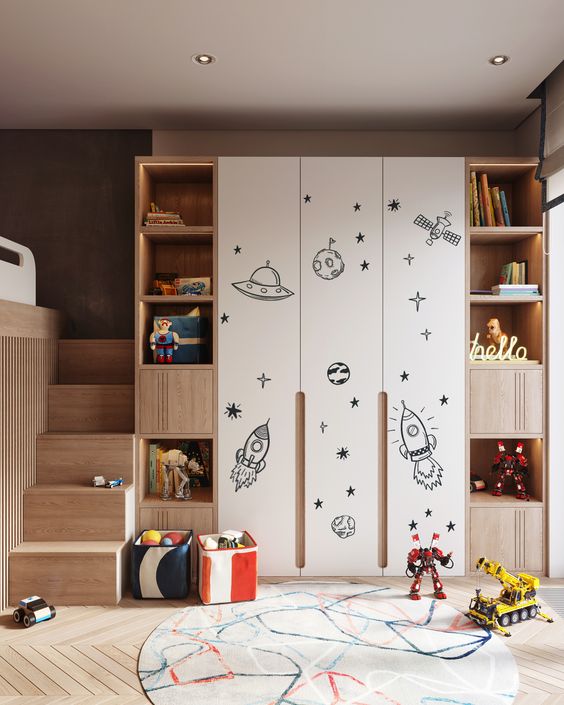
When selecting home furniture, we typically follow a familiar set of criteria: appropriate size, appealing design, compatibility with the room’s decor, and reasonable pricing.
However, additional factors come into play when furnishing a child’s room. Furniture in a child’s space must be comfortable, functional, and, most importantly, safe. Children spend numerous hours in their rooms, engaging in activities like playing, resting, studying, and sleeping. Thus, the parents aim to craft a nurturing and cozy atmosphere in the nursery.
A crucial item in any child’s room is the cabinet. Today’s cabinets are much more than mere storage spaces for a child’s belongings, clothing, and linens; they are vital components of the room’s design.
A well-chosen cabinet can mitigate room layout flaws, segment the space into distinct functional areas, and add a unique touch to the overall ambiance.
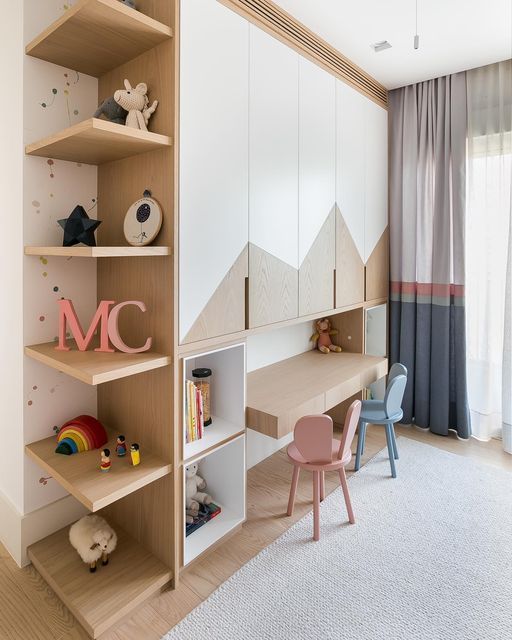
Types of Children’s Room Cabinets
Cabinet furniture makers offer a diverse array of cabinet models for children’s rooms, each distinguished by unique design aspects and varying across several dimensions:
- structural design
- shape and size
- door-opening mechanism
- facade material and design
- intended use and placement within the room
- the configuration of the interior compartments.
Cabinets’ Structural Design
Cabinets are categorized based on their structural design into
- Stand-alone Cabinets – These are traditional cabinet models featuring a full structural framework, including back and side panels and bottom and top surfaces. Stand-alone cabinets vary in width and height, ranging from slim to full-sized, and can be straight or corner units with swinging or sliding doors. Their primary benefit is mobility; they can be relocated as needed. These cabinets are typically available in standard sizes and can be purchased ready-made.
- Modular Cabinets – These cabinets are designed as a collection of individual units or blocks, each with different functionalities (modules). They are customizable according to customer preferences and assembled like a building set from the available module options. The final price of a modular cabinet is influenced by factors such as its dimensions, internal configuration, number of modules included, and the materials used for the facades.
- Built-in Cabinets – This type of storage system typically lacks side walls, bottom, and top panels and often comes in a cabinet-style design without a back wall. Built-in cabinets are mounted directly onto the room’s walls, with sliding door tracks affixed to the ceiling and floor. These are custom-made and tailored to fit the specific dimensions and characteristics of the room, enabling a seamless “wall-to-wall” installation. Due to their ergonomic design, built-in cabinets are a space-efficient choice, even for more minor children’s rooms. However, a notable drawback is their immobility; these cabinets cannot be easily relocated once installed.
- Partially Built-In Cabinets – These corner cabinets incorporate structural elements, such as a single side wall, blending built-in and freestanding features. Like fully built-in cabinets, these semi-integrated models are custom-made and fixed in place, meaning they cannot be moved after installation.
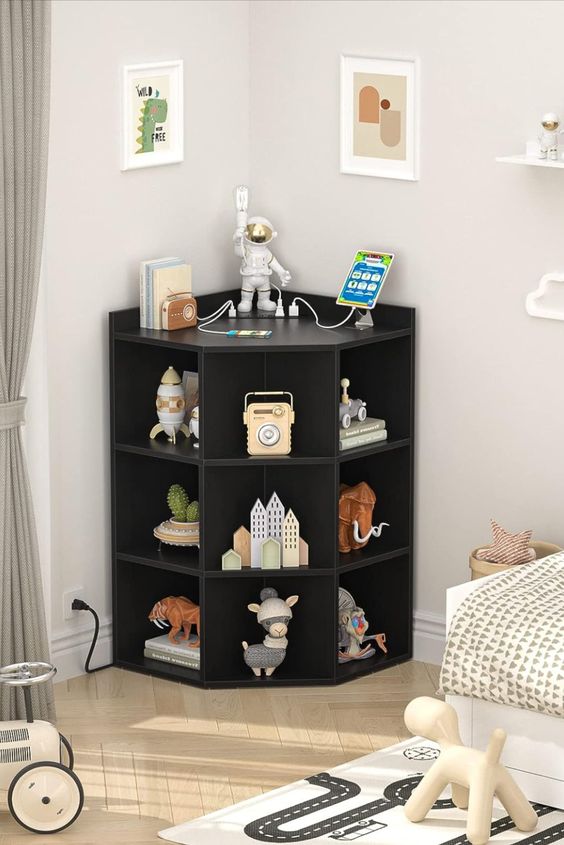
Cabinets’ Shape and Size
Children’s room cabinets are categorized by shape into:
- Linear Cabinets – These are the most basic and adaptable designs. Typically positioned along a single wall, they can also serve as room dividers for partitioning a child’s room. Linear cabinets come in various types, including stand-alone, built-in, and partially built-in models.
- Corner Cabinets – This category encompasses several styles: triangular cabinets that neatly bisect a room corner; pentagonal (trapezoidal) designs, and radius cabinets with curved edges. Often, corner cabinets are paired with additional elements like linear cabinets, shelving units, or corner shelves. Their placement in a room’s corner effectively utilizes available space, alters the room’s geometry, and adds a distinctive touch to the decor.
- U-shaped Cabinets – These cabinets occupy two adjoining corners, forming a ‘U’ shape. Known for their ample storage capacity, U-shaped cabinets offer storage on three sides, making them ideal for organizing children’s clothing, bedding, and a vast array of toys.
Door-Opening Mechanism
Cabinets for children’s rooms can be categorized based on their door-opening mechanisms:
- Hinged Door Cabinets – The hallmark of hinged cabinets is hinges that allow the doors to swing outward. This style represents a traditional approach to cabinet design.
- Sliding Door Cabinets -These doors glide sideways along specialized tracks, making them suitable for both spacious and more minor children’s rooms. Sliding doors are particularly advantageous in conserving space, as they don’t require the area needed for doors to swing open. The smooth operation of these doors relies on a roller mechanism, which is crucial in a child’s room where furniture is frequently used.
Therefore, investing in high-quality sliding systems from reputable manufacturers is advisable. Quality mechanisms and sturdy fittings are essential for ensuring long-term safety and convenience.
- Combined Door Cabinets -This design incorporates sliding and swinging doors, offering a versatile solution that adapts to a child’s room’s different spatial and functional needs.
Cabinets’ Facade Material and Design

Various materials are utilized in crafting the front portion of cabinets (facades) for children’s rooms.
Certified materials are always used in producing children’s furniture, especially by reputable furniture outlets. Among these, a few key options stand out:
- Natural Wood Facades – Cabinets crafted from solid wood are arguably among the best choices. However, they come with two significant considerations. The first is their higher cost. The second involves regular maintenance, such as applying natural oils or water-based varnishes. This type of furniture is ideal only if you’re prepared for meticulous and regular upkeep.
- Veneered Facades – For those who prefer the look of wood without high maintenance, veneered facades are an excellent alternative. They offer the aesthetic of wood without the need for constant oiling and careful handling. Veneered furniture provides a hassle-free option while being more budget-friendly than solid wood equivalents. This choice allows for the inclusion of wood in your decor without the added stress and expense.
- MDF Facades – Crafted from wood fibers bound with specialized components, surpasses solid wood in durability. Notable for its practicality and a wide array of design options, MDF allows for customization in any color or film shade you desire. Such versatility in MDF makes it an ideal choice for children’s room interiors, offering both aesthetic appeal and safety. It’s a reliable, child-friendly material that aligns with health standards.
- Laminated Particle Board – Recognized as the most economical option, laminated particle board, however, includes a degree of formaldehyde due to its production process. This necessitates careful consideration of safety standards when selecting this material for furniture. The limitation of laminated particle boards is its vulnerability to damage. Like wood, it is susceptible to impacts, but unlike wood, where dents and scratches might be fixed with furniture putty, laminated particle board tends to develop irreparable chips. This characteristic is crucial to consider, especially in environments where furniture may undergo rougher usage.
- Mirrored Facades – This type adds a unique charm and dimension to a child’s room, reflecting natural and artificial light. Mirrors serve as tools for fostering a sense of style and neatness in children.
- Material Combinations – If challenging affordability and quality, opt for mixed material solutions! The facade of furniture isn’t just the focal point of a room; it’s also the part most subjected to wear and tear. Whether it’s a child rolling toys or doodling near the furniture, the facade must be durable and versatile. By choosing a smart mix of materials, you achieve a balance between cost, eco-friendliness, and longevity.

- Colored Glass with Film Facades – These facades bring a vibrant touch to a child’s room decor. Cabinets featuring colored glass facades can become standout pieces, with varying film colors and shades allowing for bold and creative design expressions. The film serves dual purposes – it acts as a protective layer and a decorative element, ensuring the glass remains intact if damaged.
- Photoprint Facades – This type of facade is an exceptionally fitting choice for children’s room furniture. The versatility of photo-printing technology allows for the realization of unique designs, with the capability to apply any imagery onto the facade. For a child’s room, a cabinet adorned with beloved fairy tales or cartoon characters can be both functional and a source of joy.
Child’s Room Storage Ideas
The effectiveness of a cabinet in a child’s room hinges on its size and the arrangement of its internal compartments. Various storage solutions can be found within the confines of its sliding doors, including shelves for linens, drawers, toy bins, and hangers for outerwear, all part of a contemporary storage system.
While customizing the cabinet’s interior, consider your specific storage needs. To store small toys like building blocks, consider using plastic baskets and containers, ideally placed in the lower sections of the cabinet. Additionally, ensure there are shelves for art supplies, board games, and stationery items.
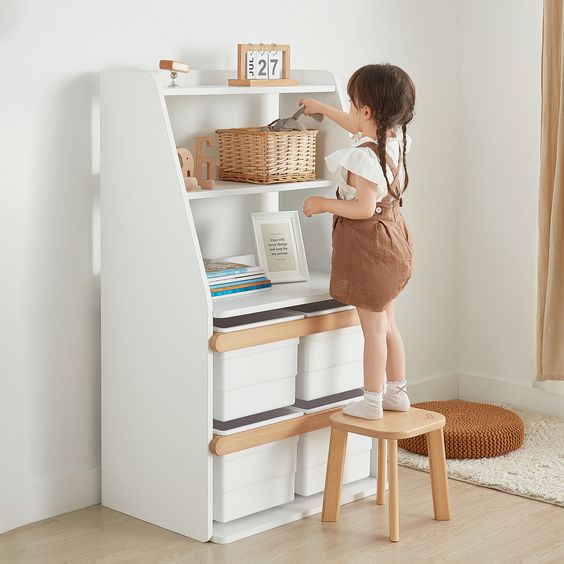
Child Safety in Cabinet Design
Children’s safety is paramount in selecting furniture. When choosing a cabinet for your child’s room, remember these safety aspects:
- Softened Edges and Handles – Select cabinets with rounded corners and handles to minimize the risk of injury, as children often play and move swiftly around the room.
- Non-Toxic Materials – Ensure the cabinet is eco-friendly and hypoallergenic. Given children’s time near their cabinets, the materials must be safe and non-irritating.
- Wall Anchoring – Secure the cabinet firmly to the wall to prevent any tipping incidents. This is particularly crucial if you have younger children who might climb on the furniture or open multiple doors simultaneously.
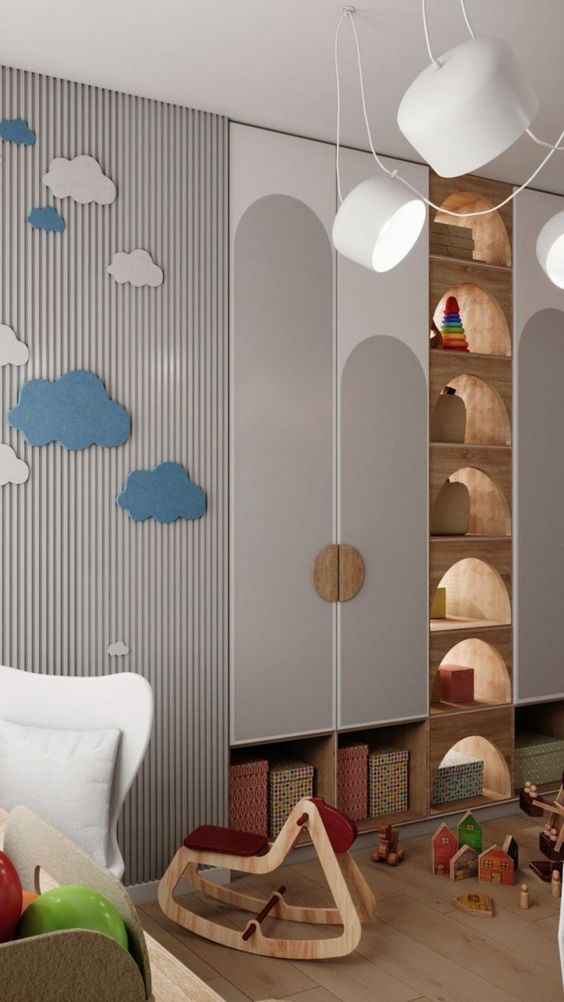
Considerations when Selecting a Child's Room Cabinet
- Prioritize design, materials, and hardware safety. The furniture’s structure must be stable and safe. If the child’s cabinet includes glass features, it must be shatterproof and safe to prevent injuries. The quality of LDF boards is also vital – they should adhere to stringent safety standards.
- Think of childproof lighting elements. If the cabinet incorporates lighting or decorative lights, ensure the child cannot access bulbs or wires for safety.
- Access durability for intense use. Children’s furniture undergoes rigorous use; therefore, selecting cabinets with robust sliding mechanisms that can withstand frequent operation is essential.
- Adhere to a functional interior layout. The internal configuration of the child’s cabinet should be thoughtfully planned. This encourages the child to use the cabinet independently, fostering a habit of organization. Modern children’s cabinets come equipped with various internal elements like baskets, rods, and specialized hangers to cater to different storage needs.
- Embrace aesthetics and design. The facade design plays a significant role in the overall appearance of the cabinet. The design choice may vary between those suitable for boys and girls.
- Consider the impact of color. The color scheme of the cabinet can influence a child’s development. Bright colors are uplifting; red stimulates mental activity, orange sparks creativity, and green is calming. However, it’s also beneficial to consider the child’s personal preferences in color choice.
- Choose a suitable model. A sliding door, or ‘coupe’ style, is often the best choice for a child’s room. A cabinet-compartment model optimizes space utilization and provides easy access to contents. Additionally, sliding doors are space-efficient and reduce the risk of injuries with swinging doors.
Ultimately, choosing a child’s room cabinet involves balancing functional requirements with safety considerations and aesthetic appeal, ensuring the cabinet is not just a piece of furniture but a meaningful addition to the child’s growing environment.
